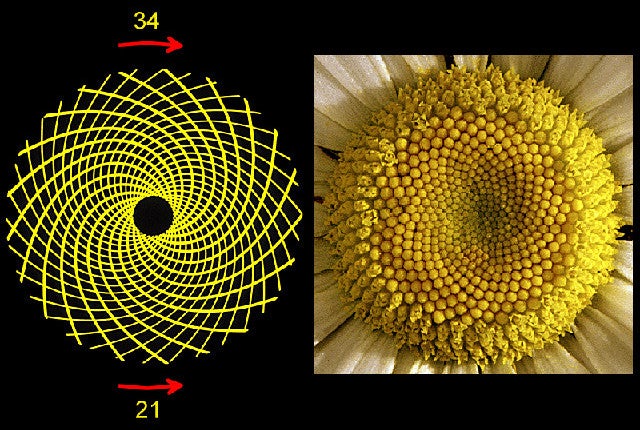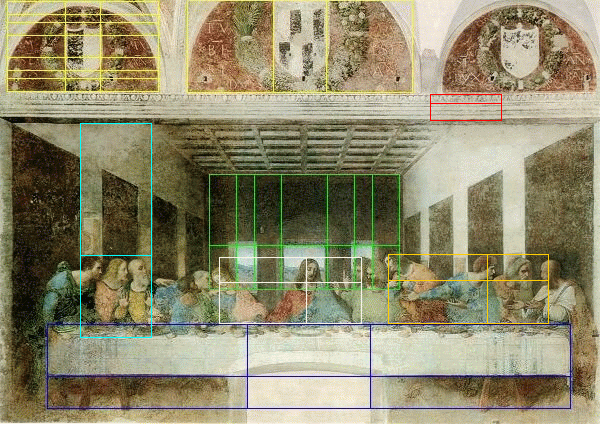Week 2: Math + Art
It was fairly clear to me even before this week's assignment that mathematics played a key and pivotal role in artwork today as well as the past; however, what did surprise me was how much shapes in nature followed mathematical principles. For example, the seed heads of flowers follow the Fibonacci numbers in an uncanny way. One flower that follows the number system almost perfectly is the sunflower. This flower provides a stunning example of this type of spiraling pattern. The seedbeds of the sunflower can be as large as 144 seeds that are tightly compacted, but the sequence will still closely follow that of the Fibonacci numbers.This type of instance in nature is not rare though. Many different objects follow similar sequences to that of the sunflower such as pinecones and the number of petals on flowers. But, many instances in nature follow other mathematical sequences. For instance, their are many examples of the golden ratio. This proportion being about 1: 1.618, is very common throughout all types of nature. Things such as tree limbs and shells are very common objects that display the golden ratio all across the world. What I found really interesting about the golden ratio was that our galaxy, the Milky Way, even follows this ratio.
These concepts, however, are not solely found in nature. Many famous artists used these mathematical concepts to make their pieces of art more aesthetically pleasing to the eye. Famously, Leonardo Da Vinci commonly used the golden ratio as well as linear perspective in his pieces which made the overall look of the painting much more pleasing to viewers. One of his most famous works of art, "The Last Supper", adopted these methods which helped to create one of the most recognizable paintings of all time. Using computer technology today, we were able to dissect much of the painting and see just how he utilized perspective as well as the golden ratio. It's is really quite amazing how artists during the 1500's were able to use such complex concepts in their artwork to make their painting have more appeal even without the help of advanced technology.
Originally, I had assumed that math and science played only a small role in art concepts; however, after going through the information provided for this week as well as doing my own research, I was shocked by how interconnected the "two cultures" really were with each other. It is truly amazing how significant mathematics is in creating pieces of art and how artists really benefitted from many different mathematical concepts. Even today, their are still many instances of art and math/science being integrated. For me, the most prominent and impressive being architecture. The designs of the buildings not only utilizes numerical systems, but also artistic concepts that help make buildings more pleasing to look at. M.C. Escher was one such major designer who created beautiful graphic artworks that would be displayed around and on buildings by utilizing the golden ratio as well as the Fibonacci numbers. Even though all these concepts seem so separated from each other, once combined, truly amazing things happen.
Works Cited
Meisner, Gary. “The Golden Ratio in Art Composition and Design.” Goldennumber.net, 4 May 2014, www.goldennumber.net/art-composition-design/.
Leary, Catie. “How the Golden Ratio Manifests in Nature.” MNN - Mother Nature Network, Mother Nature Network, 21 Nov. 2017, www.mnn.com/earth-matters/wilderness-resources/blogs/how-golden-ratio-manifests-nature.
Dvorsky, George. “15 Uncanny Examples of the Golden Ratio in Nature.” io9, io9.Gizmodo.com, 20 Feb. 2013, io9.gizmodo.com/5985588/15-uncanny-examples-of-the-golden-ratio-in-nature.
“The Rise of Renaissance Perspective.” Perspective: The Rise of Renaissance Perspective, www.webexhibits.org/sciartperspective/raphaelperspective1.html.
Smith, B. Sidney. "The Mathematical Art of M.C. Escher." Platonic Realms Minitexts. Platonic Realms, 13 Mar 2014. Web. 13 Mar 2014. <http://platonicrealms.com/>



It is very interesting that you pointed out the similarities between the Fibonacci numbers and nature, specifically in the sunflower example. I have never thought of them being so closely related. In my mind, Fibonacci numbers are just integers -- a simple math concept of how every number is the sum of the two preceding ones. Therefore, after I read your blog, I had to google how Fibonacci numbers look like visually. It is amazing how art and math are related in an area we least expected them to.
ReplyDeleteI really enjoyed your insight into the Fibonacci sequence and the beautiful yellow flower you showed. I had never thought to look so closely at a sunflower in order to see the sequence of the center of its seeds. I also had no clue that our own galaxy followed the golden ratio! I would love to hear more on why scientists think this is the case and why that particular number may have an importance significance in nature. The fact that people are now using mathematical equations to discern works of art and the correlation to the pleasingness to the eye is fascinating to me. I wonder how much more we could determine of other art work using similar methods to this. Architecture is such a classic example of the combination of math and art and I am glad you recognize it as such in this blog post. And I totally agree with you that this combination can create amazing things.
ReplyDelete